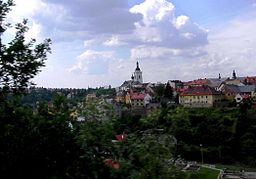Stříbro
| Stříbro | |||
| Town | |||
|
Town centre
|
|||
|
|||
| Country | Czech Republic | ||
|---|---|---|---|
| Region | Plzeň | ||
| District | Tachov | ||
| Commune | Stříbro | ||
| Municipalities | Butov (Czech Republic) | ||
| River | Mže | ||
| Center | Náměstí Svobody | ||
| - elevation | 399 m (1,309 ft) | ||
| - coordinates | 49°45′16.1″N 12°59′59″E / 49.754472°N 12.99972°ECoordinates: 49°45′16.1″N 12°59′59″E / 49.754472°N 12.99972°E | ||
| Area | 47.78 km2 (18.4 sq mi) | ||
| Population | 7,746 (2015-01-01) | ||
| Density | 162/km2 (420/sq mi) | ||
| First mentioned | 1183 | ||
| Mayor | Bohuslav Červený | ||
| Timezone | CET (UTC+1) | ||
| - summer (DST) | CEST (UTC+2) | ||
| Postal code | 349 01 | ||
| Statistics: statnisprava.cz | |||
| Website: www.mustribro.cz | |||
| Stříbro | |
| Municipality with Extended Competence | |
| Country | Czech Republic |
|---|---|
| Region | Pilsen |
| Parts | Bezdružice, Stříbro |
| Area | 430.75 km2 (166.31 sq mi) |
| Population | 16,609 (2005-31-12) |
| Density | 39/km2 (101/sq mi) |
| Stříbro | |
| Municipality with Commissioned Local Authority | |
| Country | Czech Republic |
|---|---|
| Region | Pilsen |
| Little District | Stříbro |
| Municipalities | Benešovice, Černošín, Erpužice, Kladruby (Tachov District), Kostelec (Tachov District), Kšice, Olbramov, Ošelín, Prostiboř, Skapce, Stříbro, Sulislav, Svojšín, Sytno, Trpísty, Únehle, Vranov nad Dyjí, Záchlumí (Tachov District), Zhoř (Tachov District) |
| Area | 328.08 km2 (126.67 sq mi) |
| Population | 13,891 (2005-12-31) |
| Density | 42/km2 (109/sq mi) |
Stříbro (Czech pronunciation: [ˈstr̝̊iːbro]; German: Mies) is a town in the Pilsen Region of the Czech Republic.
The mining town is located on the Mže river in the west of the historic Bohemia region, some 25 km (16 mi) to the west from the region capital of Plzeň.
Stříbro is also the seat of the Municipality with Extended Competence.
The Czech name derives from silver (Czech: stříbro), which used to be mined there. The German name Mies comes from the name of the river Mies/Mže (Latin: Misa).
According to the 16th century chronicler Wenceslaus Hajek, the mining settlement in the Duchy of Bohemia was founded by the Přemyslid duke Soběslav I in 1131. Located on an important trade route (Zlatá cesta, "Golden Road") from Prague to Nuremberg, it was first documented in 1183, when Duke Frederick and his consort Elizabeth of Hungary dedicated the first parish church to the Order of Malta. In 1243 King Wenceslaus I of Bohemia left the commandry to the Knights of the Cross with the Red Star. Mies received town privileges in 1263. The Czech name Stříbro is documented from the 14th century onwards.
...
Wikipedia





